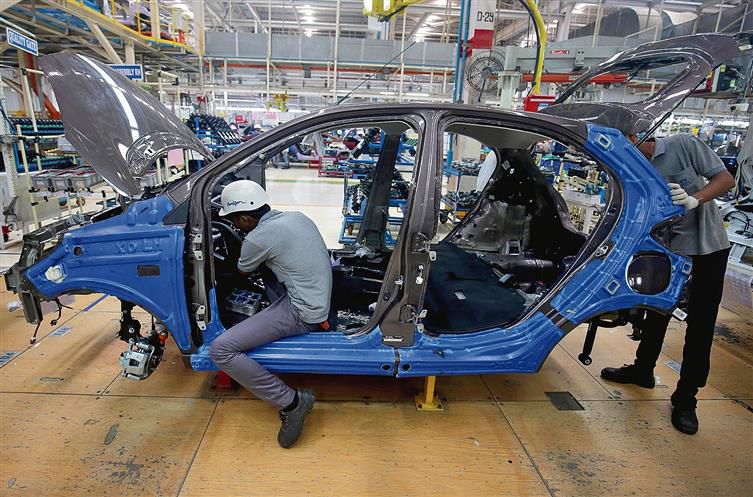
Big contributor: Automobiles account for over 45 per cent of India’s manufacturing GDP. Reuters
Sushma Ramachandran
Senior Financial Journalist
ELECTRONIC goods, led by mobile phones, became a surprise leader in India’s exports last year. The automobile industry is now looking to spring a similar surprise by becoming a rising star in the export basket. It is gearing up to become a global hub of supply to the world. It may not be as dramatic a rise as in the case of mobile phones, but it seems that auto majors are finally viewing India as a viable base for exports. Till recently, investments in projects in this sector have been made largely with a view to tapping the enormous domestic market. This despite strenuous efforts made over the years to spur multinationals to make this country a base for supplying components and finished automobiles to the world.
The insistence on maintaining global standards is not just essential for consumers’ safety, but it also makes products acceptable in world markets.
As per recent reports, leading Japanese manufacturers like Honda, Toyota and Suzuki are keen to supply India-made cars to even their home market. Such a unique development is akin to Indian subsidiaries of Swiss companies sending watches to Switzerland. The move speaks volumes about the improved quality and competitiveness of Indian passenger cars as the standards for imports are reputed to be extremely high in Japan.
Some car models are now being made exclusively here and exported both to Japan and Southeast Asia. These are the same manufacturers who were wary of investing in this country in the 1980s, when Suzuki took the plunge and set up a joint venture with the Indian government. Osamu Suzuki was considered a maverick of the Japanese auto ecosystem for having taken this decision in a risky, untried market. Honda and Toyota as well as US and European manufacturers made investments over a decade later. It took them many years to overcome reservations about dealing with bureaucratic complexities and intricate regulations in India.
South Korean manufacturers like Hyundai were quick off the blocks and entered the Indian market in 1996. This is probably why their marketing and distribution systems are able to match those of Suzuki. Both joint venture Maruti Suzuki and Hyundai have been the market leaders for many years now. As far as car exports are concerned, they remain the bigger players as well. Yet, the total passenger car export volumes are still not enough to bring India on the list of the top 10 global exporters.
Even now, it will be a Herculean task for car exports to reach the level of top suppliers like China and Germany. In fact, the entire automobile sector, including commercial vehicles, two-wheelers and three-wheelers, recorded a dip in exports during 2023. The only segment showing an upswing was passenger cars, which rose by about 6 per cent. The rise in this segment is being attributed to improvements in supply chains as well as the easier availability of semiconductors, the key component whose shortage had stalled production over the past few years.
The slowdown in demand in other vehicle categories is largely due to a faltering economic revival in major export destinations. Geopolitical conflicts, including the Ukraine war, have hit emerging economies, which are among the key markets for commercial vehicles and two-wheelers. Consequent foreign exchange constraints have apparently hit purchasing abilities in these countries, leading to a dip in exports.
Passenger cars, on the other hand, are being shipped to a variety of countries/regions, including Mexico, West Asia and North Africa. South Africa is also emerging as a market, especially for electric vehicles (EVs), while Maruti Suzuki is reported to be sending cars as far away as South America.
What has now given greater heft to the prospect of a leap in car exports is the fact that Indian emission and quality norms are broadly up to international standards. This ensures that cars being produced here can meet the exacting standards of developed economies like Japan. For instance, Toyota is currently exporting e-drives, a critical component in cars with advanced hybrid technology. As much as 70 per cent of the production is reportedly being set aside for exports. Similarly, Maruti Suzuki is planning to send its first lot of EVs to Japan and Europe.
It is in this backdrop that one must recall the efforts of the automobile industry to dilute international safety norms for vehicles made in this country. For instance, airbags, which have been the norm in developed countries, were not a standard accessory in cars here for a long time. The excuse given by manufacturers was that costs would rise dramatically for consumers. These have now been made mandatory for most models. Emission norms have also been stringent and kept up with international regulations. The lesson here is that the insistence on maintaining global standards is not just essential for consumers’ safety but also makes products acceptable in world markets.
As for the future, a study last year by consultancy firm Arthur D Little said India had the potential to become a $1-trillion auto export powerhouse by 2035. Currently, it is the fourth largest market in the world, valued at $250 billion. Automobiles account for over 45 per cent of the manufacturing GDP.
Market leaders like Maruti Suzuki have already set targets envisaging a three-fold rise in exports over the next five years. The strategy for smaller domestic players like Renault Nissan is to use Indian plants largely for exports, with 65 per cent of the output already allocated for this purpose.
In order to achieve a big leap in exports, much will depend on the ability of the automobile industry to leverage its current advantages. These include lower manufacturing costs, cheaper labour and availability of skilled manpower, along with a highly developed ecosystem of component suppliers. The latter has evolved over the past few decades and become the backbone of the Indian automobile sector. What needs to be seen now is whether the industry will be able to resist the temptation of meeting the demand of a large and expanding domestic market or take on the challenge of exporting to the world. The new government will need to drive policies to ensure that exports become an attractive option. Both policymaking and good business should meld so that the forecast of India becoming a global auto export hub finally becomes a reality.
Join Whatsapp Channel of The Tribune for latest updates.




























